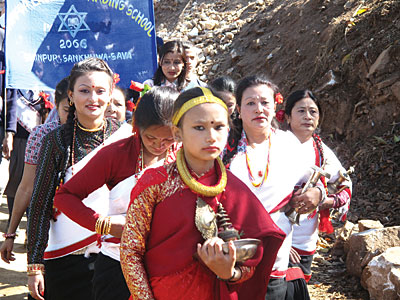 VIJAY LAMA |
In the 23 years I have been a pilot, I have crisscrossed much of this beautiful land of ours. From the air you see the incredible geographic diversity of this country, how it is laid out like a staircase to the heavens. From the hazy plains, through the rippled blue-green midhills to the dazzling saw-tooth of the northern horizon.
And wherever I land, in Simkot or Dhangadi, Taplejung or Bhadrapur, I meet Nepali men and women who are living proof of how our varied topography is reflected in Nepal's ethnic mosaic.
During the war, the people I met had just one concern: peace. Because I wore a smart uniform and came down from the sky, perhaps, passengers thought I would know, so they'd ask: "Shanti kahile aunchha hola?" Today, four years since the war ended, they are confused, disillusioned and fearful about the future.
Rural Nepalis are not demanding. They are satisfied with the little they have. They don't have great expectations. Most wake up in the morning, just wanting to get through the day, working in the fields growing enough to feed their families. They don't expect much from Kathmandu, and have long stopped demanding anything from their rulers.
I am a typical Nepali urbanite, and like many of you reading this, I have grown more and more disenchanted with the so-called New Nepal. All I see around me is cynicism, negativity and despair. So when I got an invitation to attend the Chainpur Festival recently, I jumped at the chance to get away from it all. I am really glad I did, it restored my hope in Nepal's future.
We travelled by road from Dhankuta to Hile, along the spectacular forested ridge road to Basantapur and then down to Chainpur. High above, the pyramid of Makalu kept us company like an old friend. Chainpur was alive with the anticipation of the festival the following day, and despite the chilly night people from all classes and ethnicities mingled. The war and the memory of the fierce battle here six years ago had begun to fade. People from different political parties were working together putting up welcome banners.
That evening I had dal bhat, scented with pure Chainpur ghiu. Our host told us the aroma came from the herbs that the cows ate in the high altitude pastures of eastern Nepal. The old world hospitality and spontaneity towards total strangers touched me deeply. It reminded me of the sense of belonging that comes to me when I fly passengers wearing tika and marigold garlands at Dasain. I have always felt privileged to be the one uniting Nepalis by flying them to be together.
The next morning, Chainpur's quaint cobblestone lanes were filled with people dressed in daura suruwal, haku patasi, bakkhu, and the ethnic garb of the Tamang, Magar, Rai and Limbu. Whatever they were wearing, they were all speaking Nepali with a distinctive Chainpur lilt. That morning in Sankhuwasabha, I felt convinced more than ever before that it is our diversity that unites us, and it is the Nepali language that is the mortar binding the bricks of our nationhood. Chainpur that day looked like a garden, and the voices sounded like a symphony.
The procession ended at the Tundikhel. Prime Minister Madhav Kumar Nepal landed his formerly-royal Super Puma in a cloud of dust. People clapped. But a group of Maoist youngsters started waving black banners and shouting "murdabad". The entire atmosphere changed, people became tense, and started running helter-skelter. The riot police charged the protestors. When the ceremonies resumed, the carefree feeling had evaporated.
Till the politicians arrived on the scene, Chainpur was Nepal in a microcosm. No one saw each other as belonging to this or that party, or ethnicity. We were all Nepalis. We shared what we had with strangers without expecting anything in return.
Nepal Ama is broke, she can't give anymore. It's time for us to give back to Nepal Ama what she gave us. I thank the people of Chainpur for inviting me and for opening my eyes to the reality of the real Nepal that I had never seen from the air.
Capt Vijay Lama is a pilot for Nepal Airlines.
READ ALSO:
I'm a Nepali first, by Vijay Lama - From issue #328 (22 Dec 2006 - 28 Dec 2006)



